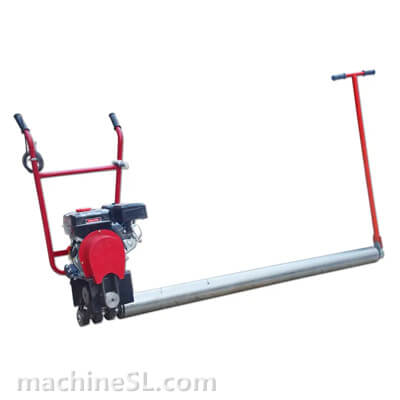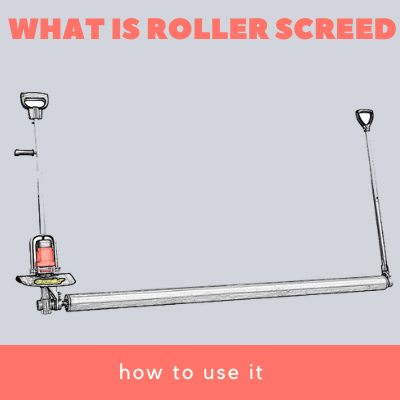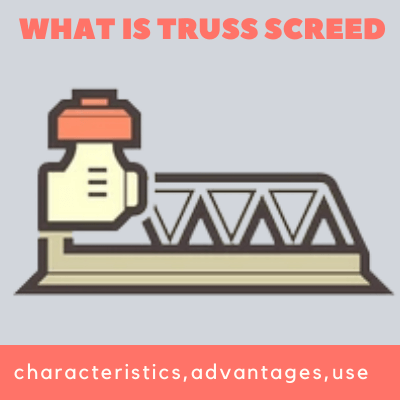How To Build Concrete Power Screed And Finish Concrete

Screeding is the process of finishing concrete to achieve a smooth level surface.
Screeding is done using a screed which can be either machine powered or hand-powered. You can buy the screed easily from different manufacturers. Though it is not an expensive piece of equipment it still costs you a few bucks.
In jobs where you do not require a high amount of finishing, buying a concrete screed could add up a greater proportion of costs. In such cases, if you can make a screed at home, why you should not go for it. Making a simple hand-powered screed is quite easy. You will only need a straight flat piece of wood or metal along with some wire attachments and a mechanism for checking the level.
However, for manual concrete screed, you would be needing a helping hand for finishing purposes. On the other hand for power screed, you can finish concrete all by yourself.
In this article, we will show you how you can make a power screed at home all by yourself and how you can finish the concrete.
concrete power screed,start from $300
Contents
How To Build Concrete Power Screed (DIY)
You need to follow few major steps to make a concrete screed at home:
- The first thing you would be needing is an engine which you can use to power the screed. You can buy it online easily. Usually, an engine of 190 cc or less works fine. Use of high powered engine is not recommended.
- Connect the shaft at the bottom of the engine to a one-inch shaft at the bottom that will have the counterweights. Print two templates for the counterweights and glue them to quarter-inch scrap steel.
- After that put, the scrap steel on the lathe and make it nice and round. Drill some holes and cut it up and that should take care of the counterweights.
For cutting and rounding the steel you may have to go to a steel forger or workshop. You can do it at home if you have the right piece of equipment and expertise for doing so.
- After cutting and rounding the counterweights, you can check their balance by mounting them on a drill in a way they form a circle. Rotate the drill. If the drill does not vibrate this means that the weight is made perfectly.
- Next thing is to prepare a shaft that connects the counterweights to the steel beam. That shaft should be long enough so that it can pass through the beam and the counterweights simultaneously and can easily be tightened.
The beam is usually made of cast iron with a channel-shaped cross-section. The thickness of the beam can be anything between 8 mm to 15 mm and its length could ideally be 1 or 2 ft. Note the purpose of the beam is to transfer the vibration from the engine to the finishing plate.
- Now once you have connected the counterweight with the beam using a shaft. The next thing is to attach the beam to a flat metal piece that will serve the finishing purpose.
- Now the lower part is ready. Connect the engine to the shaft. Now shaft has at one end counterweights and the other, we have the engine. In between, there is the beam which is then connected to the flat finishing part.
The function of counterweights is to provide vibrating action. When you do not want any vibrations you can align them in the form of a circle. Alternatively, you can misalign them for producing vibrations.
- The last step is to attach the handles to the engine that can be used to steer the screeder. The handles are usually made of aluminum. You can also put a cage around the engine for handling purposes and moving it easily from site to site.
How To Finish Concrete (DIY)
In the previous step, we showed you how to make a concrete power screed at home if you have some tools available with you in your workshop. The next thing is now we will show how to finish concrete at home all by yourself.
- First thing is that you need to make the levels around the edges. To do this you barrow in the screen and pour it along the edges then smooth it off with a spade roughly. Where the finished floor is going to be then with the screen rules.
- Compact the screed using a forward and backward motion. Making sure it’s level from the finished floor.
- Once you have your level guides around the edge you can start with infilling.
- Rolling the screen in the forward and backward motion using the edges as guides and then filling in any hollows.
- Again repeating once you have an area ruled we can get out the float with a firm grip and circular motions. We can neaten up the edges being careful not to dig in. Of course, at this stage, if there are any small little hollows in the screed they can be filled in with just a bit of screed and then floated over nicely.
- Once a section has been floated up then, you can get out the steel trowel to give it a nice going over. Then repeat this process all the way along. If there’s a bit of excess just scoop it away nicely.
- Now starting from the top roll of the floor in a forward and backward motion using the already screeded areas as a guide. Add a bit of screed to any low areas and then repeat.
- Over time, you will get a feel of how to hold the rule and at which angles you should hold it.
- So that is all the process of finishing concrete with the screed. The same process can be used with powered screed and manual screed. Though in the case of power screed, you would be requiring less human effort.
- There are some thumb rules while you are finishing. The most important of them is to no apply pressure. Second start from the edges and the areas which are difficult to finish.
You have to use a simple trowel in such cases. Another important thing to keep in mind is the number of slumps in the concrete.
Usually, manufacturers of power screed specify the concrete slump with which the machine can work. Concrete having a slump higher than the required machine slump would be difficult to finish while concrete having a slump lower than the required machine slump would simply be destroyed and cannot be finished.
vibratory screed,start from $300
Concluding Remarks
To conclude, a concrete power screed is a machine not complex to make at home. It will just need a little bit of expertise in using steel forging tools to make it at home. You would be needing an engine, a 2 feet steel beam with C shape cross-section, some cast iron pieces to act as counterweights, and lastly a flat strip of metal or wood, which will serve the finishing purpose.
In this article, we also showed you how you can finish concrete in just a few simple steps.














Leave A Comment